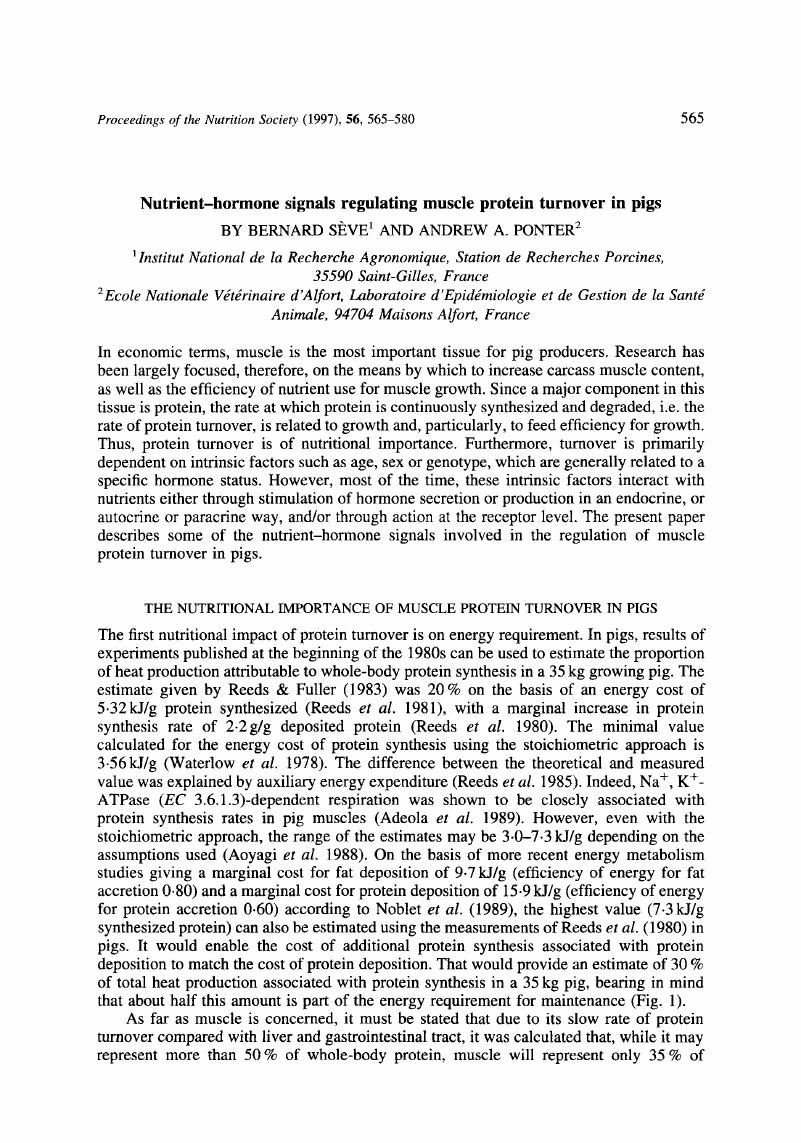Crossref Citations
This article has been cited by the following publications. This list is generated based on data provided by Crossref.
Montagne, L.
Toullec, R.
Formal, M.
and
Lallès, J.P.
2000.
Influence of Dietary Protein Level and Origin on the Flow of Mucin Along the Small Intestine of the Preruminant Calf.
Journal of Dairy Science,
Vol. 83,
Issue. 12,
p.
2820.
Oksbjerg, N.
Petersen, J. S.
Sørensen, I. L.
Henckel, P.
Vestergaard, M.
Ertbjerg, P.
Møller, A. J.
Bejerholm, C.
and
Støier, S.
2000.
Long-term changes in performance and meat quality of Danish Landrace pigs: a study on a current compared with an unimproved genotype.
Animal Science,
Vol. 71,
Issue. 1,
p.
81.
Löhrke, B.
Saggau, E.
Schadereit, R.
Beyer, M.
Bellmann, O.
Kuhla, S.
and
Hagemeister, H.
2001.
Activation of skeletal muscle protein breakdown following consumption of soyabean protein in pigs.
British Journal of Nutrition,
Vol. 85,
Issue. 4,
p.
447.
Oksbjerg, Niels
Sørensen, Martin Tang
and
Vestergaard, Mogens
2002.
Compensatory Growth and its Effect on Muscularity and Technological Meat Quality in Growing Pigs.
Acta Agriculturae Scandinavica, Section A - Animal Science,
Vol. 52,
Issue. 2,
p.
85.
Rønsholdt, Bent
and
McLean, Ewen
2004.
Effect of growth hormone and salbutamol on growth performance, fillet proximate composition and pigmentation of rainbow trout (Oncorhynchus mykiss).
Aquaculture,
Vol. 229,
Issue. 1-4,
p.
225.
Hamard, A.
Sève, B.
and
Le Floc’h, N.
2007.
Intestinal development and growth performance of early-weaned piglets fed a low-threonine diet.
Animal,
Vol. 1,
Issue. 8,
p.
1134.
Galvani, D. B.
Pires, C. C.
Kozloski, G. V.
and
Wommer, T. P.
2008.
Energy requirements of Texel crossbred lambs1.
Journal of Animal Science,
Vol. 86,
Issue. 12,
p.
3480.
Tomaszewska, Ewa
Dobrowolski, Piotr
and
Siwicki, Andrzej
2012.
Maternal treatment with dexamethasone at minimal therapeutic doses inhibits neonatal bone development in a gender-dependent manner.
Livestock Science,
Vol. 146,
Issue. 2-3,
p.
175.
Nie, H. T.
Wan, Y. J.
You, J. H.
Wang, Z. Y.
Lan, S.
Fan, Y. X.
and
Wang, F.
2015.
Effect of Age on Energy Requirement for Maintenance and Growth of Dorper and Hu Crossbred F1 Ewes Weighing 20 to 50 kg.
Asian-Australasian Journal of Animal Sciences,
Vol. 28,
Issue. 8,
p.
1140.
Dias Ferreira, Angela Cristina
Yáñez, Enrique Alejandro
de Medeiros, Ariosvaldo Nunes
de Resende, Kleber Tomas
Pereira Filho, J.M.
da Rocha Fernandes, Márcia Helena Machado
Almeida, Amélia Katiane
and
Molina de Almeida Teixeira, Izabelle Auxiliadora
2015.
Protein and energy requirements of castrated male Saanen goats.
Small Ruminant Research,
Vol. 123,
Issue. 1,
p.
88.
Conde-Aguilera, José Alberto
Le Floc’h, Nathalie
Le Huërou-Luron, Isabelle
Mercier, Yves
Tesseraud, Sophie
Lefaucheur, Louis
and
van Milgen, Jaap
2016.
Splanchnic tissues respond differently when piglets are offered a diet 30 % deficient in total sulfur amino acid for 10 days.
European Journal of Nutrition,
Vol. 55,
Issue. 7,
p.
2209.
Oksbjerg, N.
and
Therkildsen, M.
2017.
New Aspects of Meat Quality.
p.
33.
Pallotto, Marissa R.
de Godoy, Maria R. C.
Holscher, Hannah D.
Buff, Preston R.
and
Swanson, Kelly S.
2018.
Effects of weight loss with a moderate-protein, high-fiber diet on body composition, voluntary physical activity, and fecal microbiota of obese cats.
American Journal of Veterinary Research,
Vol. 79,
Issue. 2,
p.
181.
Du, S.
You, S.H.
Bao, J.
Gegentu
Jia, Y.S.
and
Cai, Y.M.
2019.
Evaluation of the growth performance and meat quality of Mongolian lamb fed grass, hay or pellets of Inner Mongolian native grass.
Small Ruminant Research,
Vol. 181,
Issue. ,
p.
34.
Du, Shuai
You, Sihan
Bao, Jian
Ge, Gentu
Jia, Yushan
Cai, Yimin
and
Miglior, Filippo
2020.
Growth performance, carcass characteristics, and meat quality of Mongolian lambs fed native grass or hay with or without concentrate on the Inner Mongolian Plateau.
Canadian Journal of Animal Science,
Vol. 100,
Issue. 3,
p.
470.
Therkildsen, Margrethe
and
Oksbjerg, Niels
2022.
New Aspects of Meat Quality.
p.
39.
Berghaus, Daniel
Haese, Eva
Weishaar, Ramona
Sarpong, Naomi
Kurz, Alina
Seifert, Jana
Camarinha-Silva, Amélia
Bennewitz, Jörn
Chillon, Thilo
Stefanski, Volker
and
Rodehutscord, Markus
2023.
Nitrogen and lysine utilization efficiencies, protein turnover, and blood urea concentrations in crossbred grower pigs at marginal dietary lysine concentration.
Journal of Animal Science,
Vol. 101,
Issue. ,





